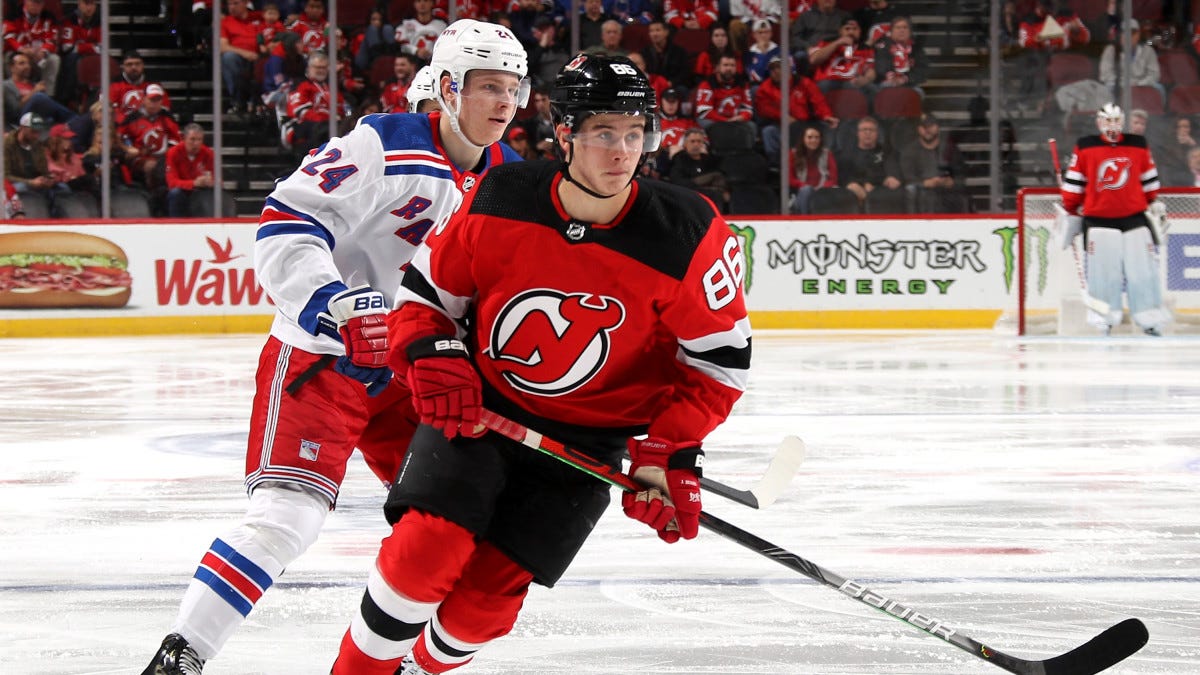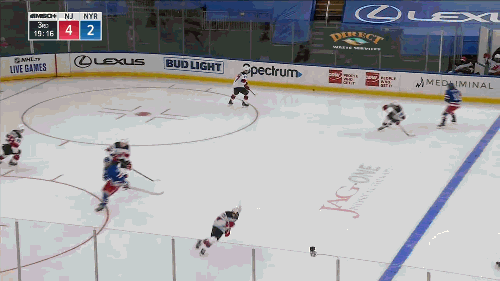Jack Hughes is going to be a fantastic player.
In 2019-20 the rookie struggled on an underperforming New Jersey Devils team. The first-overall pick touched the puck often enough, but his success rate was subpar, an indication that he was physically and mentally overmatched as a rare 18-year-old NHLer.
Read More: Jack Hughes 2019-20 Study
But in 2021 the center is finding another gear.
His most recent game (Jan. 19 vs NYR) was his best NHL performance yet. In a 4-3 Devils win NJD86 logged 14:10 at 5v5, led his team in individual expected goals and notched his first two-goal game.
Sure, Hughes just broke even in 5v5 on-ice shot attempts (+15/-15, 50% Corsi) and the Devils were just +7/-6 in scoring chances. But this is already significant progress from last year, when Hughes was a significant drag on his team’s ability to push play up-ice.
So how did he do it? It’s all about the fundamentals.
Revisiting Developmental Metrics
(From the newsletter archives)
Performance metrics such Corsi (raw shot rates), RAPM (context-adjusted shot rates) and WAR (one-number metrics) do a good job of valuating a player’s contributions relative to their peers. They provide objective, actionable evidence to inform trades, free agent signings and roster design.
But what about in a player development context, where we care more about evaluating an athlete’s progress relative to him/herself?
Darryl Belfry describes a different data-oriented approach in his recent book. Having worked with him in the TOR organization, I’ve grown to appreciate his methodology, which revolves around the idea of frequency and success rate.
Simply put, when working with players looking to optimize their game, we should track data related to how often a player executes certain actions (frequency) and how often those actions lead to a continuation play (success rate):
High frequency/high success rate (LEVERAGE): These are a player’s core strengths - we want to leverage these skills when working on weaknesses, and continue to build on them over time
Low frequency/high success rate (EXTEND): We want to research and develop ways to deploy these skills more often in-game
High frequency/low success rate (ADDRESS): These are the most valuable development opportunities - any gains we make here will scale and multiply
Low frequency/low success rate (IGNORE): We skip over these issues to focus on other areas
Even in his rookie season, Hughes’ skating ability and hockey sense enabled him to be a high-frequency offensive player. However his lack of maturity led to low success rates when he attempted to make plays.
So what was there to address?
Hughes is fast in a straight line, but he would be even more effective using changes of speed and direction (delays, cutbacks, tactical accelerations) rather than attempt to burn through opposing defenders, which he did as a junior
Hughes has elite vision and hand skills, but against seasoned NHL pros he needed to hone his timing as a playmaker: manipulate space to create small-area 1v2s, then slip the puck to a linemate for a 2v1 advantage
At 5’10” 170lb Hughes is a not a physical force, but improving his body position and his stick work can help him win more 1v1 battles outside the dots, where he struggled in Year 1
Year 2 Progress
Against the Rangers Hughes is once again an outstanding acquirer of the puck.
In 850 seconds of 5v5 ice time he touches the puck 31 times. This one puck per 27 seconds rate is elite, comparable to the McDavids, Matthews and MacKinnons of the world.
But now Hughes is also executing plays at a high success rate on his touches. On 31 attempts he amasses 25 completed passes and shots at net for an excellent 80.6% success rate. The last time he consistently completed plays at an 80% rate, he averaged over two points per game against USHL competition.
Video examples
On a NJD regroup Hughes finds space between checks in the middle of the ice, enters the NYR zone in the middle of a 1v5, escapes contact using changes of speed & direction, then completes a low-to-high pass to set up a OZP sequence.
NJD86 wins a loose-puck race in the corner by cutting in front of the NYR defender, then finds a small area play behind the net to create a shot for a teammate.
NJD86 again finds space in the middle of the ice on the regroup, wins a 1v2 at the line by making a well-timed cut, then bumps the puck to a teammate for a scoring chance.
In Summary
One game is certainly a small sample size. But when I watch Jack Hughes in 2021, I see a player who is much better able to connect his signature skills to the game in front of him.
The physical, mental and technical progress he has made during the off-season now allow him to play better under pressure and approach the game from a creation rather than a survival mindset. Mastering that mindset is ultimately how Mat Barzal, Johnny Gaudreau, Patrick Kane and other elite playmakers stand out from the pack.
Want to know more about what elite NHLers do to improve?
If you enjoy this newsletter and want to see more free content, consider ordering a copy of my e-book Hockey Tactics 2020, edited by a legendary journalist and illustrated by an artist whose work you have surely already seen. Eight chapters, more timely insights, more timeless principles. Get it now







